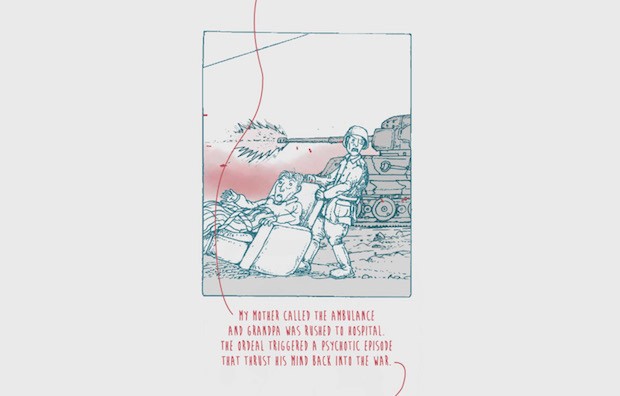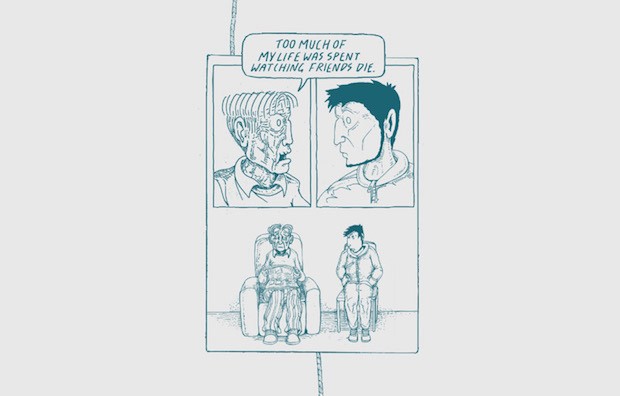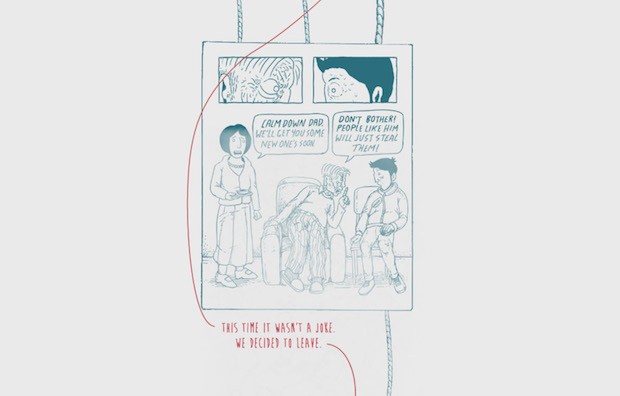“I wanted the interactivity to reflect the frustration of memory and dementia” Stu ‘SUTU’ Campbell on his highly personal webcomic These Memories Won’t Last
 We never tire of referring to Stu ‘SUTU’ Campbell as a webcomic trailblazer and pioneer, because his titles like Nawlz, Neomad and Modern Polaxis are some of the most dynamic and exciting digital comics we have seen. His latest work, These Memories Won’t Last is much more personal though, telling the story of his grandfather’s dementia. but still features his unique cutting edge brand of story-telling. We catch up with Stu to find out the secrets behind this wonderful webcomic.
We never tire of referring to Stu ‘SUTU’ Campbell as a webcomic trailblazer and pioneer, because his titles like Nawlz, Neomad and Modern Polaxis are some of the most dynamic and exciting digital comics we have seen. His latest work, These Memories Won’t Last is much more personal though, telling the story of his grandfather’s dementia. but still features his unique cutting edge brand of story-telling. We catch up with Stu to find out the secrets behind this wonderful webcomic.
What inspired you to create a webcomic about your grandfather’s ill health? Why did you choose to tell something so personal? It’s quite a departure from your usual work?
SUTU: Last year I applied for an artist residency in Vienna. The residency was for digital storytellers and the brief was to tell a story that you’ve always wanted to tell. Around the time that the application was due I happened to be visiting my grandpa who was suffering from dementia. The dementia had developed pretty quickly and I had never seen him so disorientated and confused. He was struggling and it was painful to watch. After leaving him, I found myself reflecting on that visit a lot and when it came to writing my proposal for the residency ‘These memories won’t last’ was what flowed out of me.
As much as I enjoy exploring the sci fi and fantasy themes that have dominated most of my work, I always want to challenge myself to deal with different subject matters. This story, whilst it is more simple in it’s visual style was definitely an emotional ride. I had to revisit some horrible chapters of my grandpas life and verify those stories with other family members which was also hard for them and the whole time there was a pressure to deal with the stories and events with dignity and honesty. It was tough and right now I’m really enjoying just drawing some fun and silly sci fi stuff, but at the back of my mind I can feel another serious story brewing.

You use a paralaxing website with the story coming in from the top and bottom, how did you come to use that story-telling technique? And was it created to emphasize the disorientating nature of the story?
SUTU: Yes that’s definitely one reason. You can unpack a few metaphors… The text and the images don’t always align, they’re travelling in different directions and whilst the scrolling mechanism allows the user to control the pace of the story it also sets in motion a deterioration code. Meaning, as you scroll, the story begins to fade away and you can’t go back. I wanted the interactivity to reflect the frustration of memory and dementia.
Were there any particular challenges to telling the story in that way? In particular with introducing the animated elements? It has such an ad hoc feel, but I’m guessing it required a lot of planning?
SUTU: There’s always technical challenges when doing these types of interactive projects. I drew all the panels individually and then played them out in Adobe Illustrator in the order that they would be animated. This helped me to visualise how each scene would connect to each other. I then animated the entire story on one linear timeline and then we had to connect that animation to the scroll gesture using some html5 programming and we also had to program the story to fade away depending on the reader’s progress. The animation was fairly straight forward and the bulk of the programming went smoothly until we had to test the story on multiple browsers. On one browser it would work beautifully and then on another it would break completely. It’s always a challenge figuring out the discrepancies between browsers.

You’ve also tweaked your style to feel much more diary/sketchbook like, was that an important decision for the nature of the story?
SUTU: The visual style is quite a departure from my better known sci-fi detailed worlds, but often when I begin a specific project I try not to think of it in terms of my usual aesthetic, I’m always searching for an aesthetic that will best communicate the story. I happened to see the Art Spiegelman exhibition in New York the year before and one of the things that struck me was a comment Art had made about Maus when asked why he chose to render the story the way he did i.e. animals rendered in a simple line art style. He said something to the effect that the aesthetic choice contributed to the commentary on how the war reduced humans to something less. This comment guided me through my process, as I questioned how the dementia was trying to reduce my grandpa to something less.
The use of sound is a tricky one in web and digital comics, but I felt you used it brilliantly here. How important was it for you to have a sound element to the story and were there any particular challenges in creating it?
SUTU: I love thinking about the sound design it really transforms the way I think about the nature of the story because music and sound design is so interpretative anyway. Like, what sounds constitutes sadness and vice versa. Thankfully I’ve been working with Lhasa Mencur (the sound designer) for a few years now on a few of my other projects including Nawlz, Modern Polaxis and Warlu Song. I think we’ve finally figured out a good understanding of each others workflow and Lhasa is always enthusiastic and does a great job interpreting my ambiguous descriptions of how the scenes should sound.

Congratulations on the Eisner nomination, how important are award nominations like this for bringing attention to your work?
SUTU: It’s super important. As you’ve probably noticed a lot of my work is published online for free. Sometimes I do it on my own coin and other times the projects are created via some form of funding. For one, recognition from the likes of the Eisner awards really improves my chances of getting funding. The awards and their respective institutions help to validate my work and so the funding people trust that I can do the job. Also, places like the Eisner Awards are marketing machines, so as soon as the nominations were announced hundreds of blogs across the globe shared the nomination list and suddenly my story was shared to all their audiences. Also at the time of the Eisner nomination I received a Webby nomination (which is like the Oscars for websites), so in that month my story reached over half a million readers worldwide. It’s an incredible response. And from there it started appearing on Dementia websites where it was listed as recommended reading and I also got a few emails from Universities and schools saying it had been included in their New Media curriculum as a study focus. It’s hard to know what the greater impact of this exposure will be but at the very least I hope the story serves as a reminder to the trauma of war and a better understanding of dementia.
You keep pushing the boundaries of story-telling with your comics, so what’s next?
SUTU: I just finished some artwork for Holly Herndon, a wonderful electronic musician whom I’m a big fan of and now we’re working on a short Augmented Reality story about a female robotics technician who is in the business of training robot intelligence. I’m also about half way through issue 7 of The Gatecrashers. And the BIG news, I’ve just received funding to create a Virtual Reality dreamtime story which will be created in collaboration with my Aboriginal Australian friends in Western Australia and Frame Studios out of Perth. And earlier on in the year my Neomad comic was optioned to be adapted in to an animated series – Viskatoons, a Melbourne based animation company is currently negotiating the funding for the development of the pilot episode – fingers are crossed at this time, hopefully a deal will be signed soon.
You can read These Memories Won’t Last as well as SUTU’s other ground-breaking webcomic at sutueatsflies.com



November 13, 2025 @ 7:09 am
The visual style is quite a departure from my better known sci-fi detailed worlds, but often when I begin a specific project I try not to think of it in terms of my usual aesthetic, I’m always searching for an aesthetic that will best communicate the story.